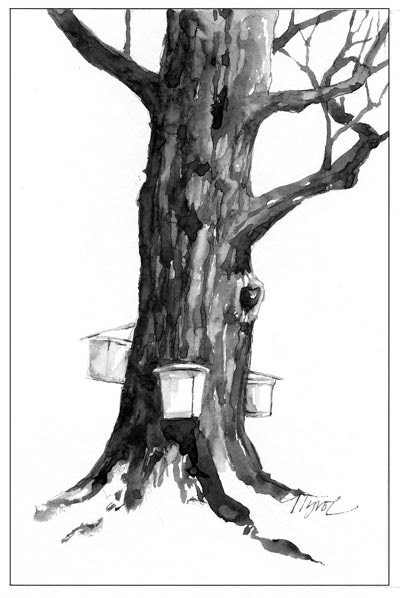
Our sugarhouse is within walking distance of an elementary school, so we’ve given tapping demonstrations to hundreds of school kids over the years. At the part where someone drills a hole in the tree and it sort of bleeds, the next question is invariably: “Does tapping hurt the tree?”
The stock answer is no, as long as you don’t overdo it: use the smaller “health” spouts, follow conservative tapping guidelines, give the tree a year off if it looks stressed. As proof that sugaring is sustainable, we point to some of the trees in our sugarbush that have been tapped for close to a hundred years and are better off for it. Better off because we thin out the trees around them, giving the chosen trees extra light, water, and nutrients. Their increased vigor, when compared to the maples in unmanaged sections of the forest, is plain to see.
But the sugarmaking being practiced today in many commercial bushes – including our own – is not the same sugarmaking that was practiced even 10 years ago. New technologies, like high-yield vacuum pumps and spouts that keep tapholes open longer, have vastly increased the amount of sap we’re collecting from each taphole. Generally speaking, we’re taking about twice as much sap per tree each spring as my grandfather took – some guys are taking three times as much.
So can a modern sugarmaker take too much sap from a tree? The short answer is probably still no. To come up with a longer, more satisfying answer, we’d first need to figure out how much sap is available to a tree at any given time, and this question gets tricky because there’s the water part of sap and the sugar part.
It’s reasonably safe to assume that water is relatively easy for a tree to come by. Twenty inches of snow converts to about 54,000 gallons of water per acre, so even if you’re taking 20 gallons of water from a tree over the course of a sugaring season, it’s a drop in the bucket compared to the moisture that’s available. The problem is that nobody knows for sure where the groundwater in the sap you’re collecting came from. Was it melting snow? Or Hurricane Irene in August 2011?
The sugar part of sap is no easier to account for, and we don’t know its history either. We do know that the soluble sugars in maple sap are part of a tree’s nonstructural carbohydrate reserves (otherwise known as tree food). Picture these reserves like a bank account that the tree adds to when it’s photosynthesizing and draws upon in the spring to open its leaves and grow its early twigs, in the fall to establish cold hardiness, and in the winter to keep living cells alive.
And we can measure these reserves.
Conventional wisdom holds that a traditional sugarmaker does not take a harmful amount of the reserves. According to a report published in 1903 by the venerable UVM maple researcher Dr. C.H. Jones, only about four to nine percent of an eight- to ten-inch-diameter tree’s total carbohydrate reserves are removed; almost no one taps trees that small, and presumably the carbohydrate loss is significantly less in bigger trees. To make the allometric model that estimate was based on, someone had to dig up a whole tree and record the live weight and dry weight of every piece – from the root hairs to the branch tips. Considering the amount of time, money, and logistics this entailed, you can understand why no one has created a model using a 30-inch diameter tree.
This isn’t to say that maple researchers aren’t reexamining the can-you-take-too-much-sap question from other angles. In 2010, Mark Isselhardt, a researcher at the Proctor Maple Research Center in Underhill Center, Vermont, measured the carbohydrate reserves of trees under high vacuum before, during, and after the season. One intriguing finding was that trees under high vacuum had slightly higher levels of carbohydrates in early summer, meaning that perhaps the trees mobilized reserves to accommodate for the additional loss, and perhaps this diversion of resources came at the expense of radial growth, which in the fall of 2011 was slightly less than the gravity-only and the non-tapped control trees. But Isselhardt cautions against taking anything from the study as gospel truth. “It’s tempting to jump to conclusions, but the sample size was small and the data lack statistical power. At best we can only say that the results add to the mystery.”
And so, for now, we’re still at “no.” People tend to see scientists as sages who have all the answers – I’m as guilty as anyone in this regard – but the truth is that they’re much better at asking questions than answering them. This can be frustrating, but it’s also kind of cool. There’s still so much we don’t know about sugaring, about nature in general. So many puzzles waiting to be solved.


Discussion *